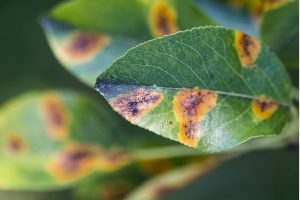General Questions
How many years have you been in business? We have been in business since 1988. We’re a family-owned and -operated Canadian company with the goal of providing superior quality and unbeatable value!
Are you an Accredited Business with the Better Business Bureau? Hometurf has been in business with the Better Business Bureau since 1994 and have consistently held an A+ rating.
What other associations are you a part of? As a professional business, we’re licensed by the government and hold long-term memberships with Landscape Ontario and the Professional Lawn Care Association.
What recognition have you received? Aside from the great feedback we receive from our customers, we have won several awards for excellence in our field. These awards include: Consumer Choice Award for Best Lawn Care, HomeStars’ Best of Award for Best Lawn Maintenance, Readers’ Choice Award for Bloor West Villager, and Top Choice Award for Best Lawn Care.
Do you guarantee your services? Our goal is to help you create the lawn you have always wanted. Homeowner maintenance and the weather play a large role in our service, however if you’re ever unsatisfied with an application, let us know and we will complete that application again free of charge.
Do you provide resprays? If you feel your most recent weed control application has been adversely affected by weather conditions, please contact our office. We will be happy to respray at no charge
What if it rains following an application? Many of our treatments are not adversely affected by rainfall. Some treatments, such as fertilization and seeding, actually benefit from the irrigation rain provides. In some instances, the effectiveness of weed control treatments may be diminished if heavy rainfall occurs within a few hours of application. If you feel your application has been adversely affected by rain, please contact our office. We will be happy to reapply your weed control treatment.
Do I have to be at home during my scheduled lawn care treatment(s)? As long as we have access to the front and back yard, we will proceed with the application as scheduled. We will leave a sign on the front lawn and paperwork on the door or mailbox with your application information enclosed.
I had an application today, can I cut or water my lawn? Following each application, a notice will be left behind stating which treatments were applied and any care instructions regarding the treatment. As a general rule, cutting should be deferred for 24 hours. Watering can be done immediately after and is not harmful unless excessive.
When do I get my applications? We follow a precise schedule to ensure your lawn is getting the right dose of nutrients. For optimal results, applications are typically scheduled 4-6 weeks apart. We include a schedule with your first application, outlining the time frame for each service. Some applications, such as late spring fertilizer and weed control, will be done together.
What if I have questions or problems with my lawn after the service starts? Our friendly customer service staff are always here to help. We hold consistent office hours and have knowledgeable staff available to assist you. If there is a problem our customer service staff cannot solve, we will send a technician to your home to follow up.
Are your products safe for pets and animals? All of our products are child and pet friendly. For liquid weed control applications, we ask that everyone, including our furry friends, stay off the lawn until the product dries.
Order and Payment
I received a letter in the mail indicating my price is $—. Is that my actual price? If you received a letter with your address on it, that is your price. You can verify the price by using our instant online quote tool. In no way are you obligated to order.
How do you determine your pricing? Our pricing is based strictly on the size of your property; the smaller the lawn, the less expensive your program will be. Geographic location has no bearing on our pricing and pricing will not fluctuate.
Did someone come out and measure my lawn? No, we acquire lot size information using the land survey. When calculating the price, we take into account the house, driveway and patio areas, and deduct those areas from the lot size. Larger properties have been allotted larger areas for the house and driveway. Pools, home additions, and other changes a homeowner may have made have not been accounted for. If you had a lawn analysis done, the size of the property has been physically checked and modified accordingly.
How do I order a program? Ordering a program is easy. Simply call our office and confirm your information with one of our staff members, then fill out the online order form found here or mail in the bottom portion of the letter you received.
When will I get my first application? If you order a program at the beginning of the season, your first application will occur in April or May once the remaining snow has melted. If you order mid-season, you will receive your first application within 2 weeks of ordering the service.
How do I make a payment? Payment can be made at the beginning of the year or in 4 installments throughout the season. The majority of customers choose to pay upfront as there are significant cost savings in doing so. Payment is due 30 days after the first application. We accept cheques, Visa, Visa Debit, Amex, Mastercard, as well as online banking payments.
Can I make a payment using online banking? Yes! Simply add “Hometurf” as a payee through your online banking institution account. Your account number is on your renewal letter, as well as all your work orders. Example: 13532BU.
Our Services
What type of fertilizer do you use? Part of our commitment to excellence is applying the best professional products to your lawn. We use the highest quality slow-release granular fertilizer available, which is manufactured specifically for our use. The slow-release fertilizer ensures your lawn always has the right amount of nutrients.
What type of fertilization do you offer for Tree’s and Shrubs? Hometurf’s Deep Root Fertilization service injects a water-soluble, plant-derived fertilizer into the canopy of mature trees and is sprayed into the soil bed of perennial shrubs and hedges. This delivers depleted nutrients directly back into the soil. These vital nutrients are then carried upwards and made available to the rest of the plant to help revitalize any seasonal damage.
What type of grass seed do you use? Our grass seed goes through an intensive research process to ensure only the best seed is planted on your lawn. All of our mixtures are 100% certified Canada Grade A mixture. Certified grass seed is more expensive but guarantees no weed presence. Just like our fertilizer, our grass seed is blended exclusively for our own use; you cannot buy it in stores!
Can I buy a bag of your grass seed? We always encourage our customers to plant good quality seed to repair areas with heavy traffic. We have small bags of seed available - just ask one of our staff members!
What is “aeration”? Enabling your lawn to rejuvenate after a long winter is important and aeration provides many benefits by allowing your lawn to receive the air, water, and nutrients it needs to replenish. At Hometurf, we offer both a liquid aeration solution and the traditional mechanical solution. Core aeration (mechanical) helps to reduce thatch, improve nutrient and moisture uptake, and ultimately enhance your lawn’s ability to withstand environmental stresses. The key ingredients in Aerify Plus, our liquid option, have been shown to improve soil’s physical properties, which helps increase root zone oxygen levels and allow for deeper penetration of water-this is a key benefit to help prevent drought stress during periods of prolonged hot and dry conditions in the summer months. Both options work to improve the overall health of your soil with long-lasting effects.
How do I know if I need an aeration? Aeration is always beneficial, even to an already healthy lawn. We recommend aeration for lawns that have been laid on mainly clay surfaces. It is effective on previously neglected lawns that were not properly watered or cut. Aeration can also be helpful to any lawn that doesn’t seem to grow at a normal rate or turn green even after being fertilized. It is not recommended for lawns with a high sand content, unless the sand is heavily compacted.
What is “Fiesta”? Fiesta is a liquid selective herbicide (Reg. NO. 29535 P.C.P Act) that is derived from iron. Fiesta has no odour, works quickly and in cool weather, and becomes rainfast in 3 hours.
What is “dethatching”? Dethatching is done with a machine that cuts vertically into the grass to loosen and remove dead grass buildup. The removed thatch is then raked by hand, bagged in clear garbage bags and left at the curb. This process is typically done in the fall and is quite traumatic for the grass, taking several weeks to recover. Dethatching is not recommended in the spring, as the ground is usually too soft and may cause damage.
Common Weeds and Pest Grasses
Least Effective: Crabgrass and Quackgrass Minimal effect on quack and crab grasses. If infestation is heavy, we recommend removing the weeds by hand. Be sure to pull the entire root and then reseed for the best results.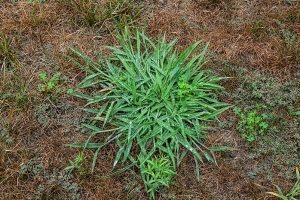
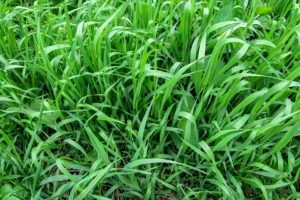
Effective: Clovers and Plantains Provides control for black medics, clovers, plantains, and many creeping weeds. Multiple applications are sometimes required for best results. If infestation is heavy, over-seeding is recommended to achieve lasting results.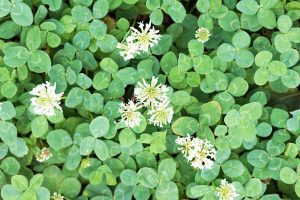

Most Effective: Dandelions and Thistle Excellent control of common dandelions and thistle with visible results within days of treatment.
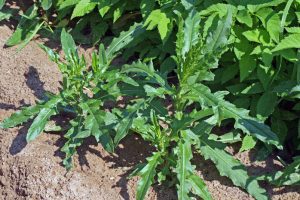
How do I know I have crabgrass? Crabgrass will start to appear in late spring depending on how hot the season has been. It is not visible in late fall. Crabgrass is lime green with short, stubby leaves and is particularly noticeable around boulevards and sides of driveways. In late summer, it is easily recognizable with its long shoots and possible red or purple colouring. Crabgrass is commonly confused with quack or field grass which are green all season long. Quack or field grass are usually mixed with good grasses and are impossible to kill without damaging the surrounding grass. All lawns have some quack or field grass.
What is “quackgrass”? Quackgrass is a type of field grass that is present in varying quantities on nearly every home lawn. This hardy, cool-season grass is one of the most difficult to eradicate and is commonly confused with crabgrass. It is clearly visible in early spring and fall, whereas crabgrass is present until June and dies off at the end of the season. Since it is closely related to the desirable grasses found in lawns, there is no non-selective process that will eliminate the quackgrass and leave the good grasses untouched. If quackgrass presence is minimal, we recommend removing it by hand. Be sure to pull out all the roots and replace the bare spots with seed. If quackgrass has taken over the entire lawn, a non-selective control can be applied, killing everything on the lawn. After the waiting period has passed, then the lawn renovation can begin.
What is “thatch”? Thatch is a buildup of dead grass that creates a barrier between the surface and the soil, making it difficult for water and other essential nutrients to reach the soil. Minor thatch problems can be kept under control by raking. We recommend raking the lawn twice per season, once in the spring and again in the fall, even if you have a mulching mower. Your lawn should also receive 1-1.5 inches of water per week, either by rainfall or irrigation. Watering in the morning is most beneficial. Cutting should be done on a regular basis, making sure to never remove more than one-third of the leaf blade in a single cutting. Aeration can also help to reduce thatch buildup. If thatch is a bigger problem, dethatching can be done for an extra charge.
Turf Damaging Insects
What is eating my lawn? In Spring: Grubs Most damage from grubs appears in spring or fall when feeding occurs close to the surface. Look for large areas of dead grass which can be peeled back by hand, much like a piece of new sod. Secondary damage is often caused by raccoons, skunks, and other animals digging at the lawn. In Summer: Chinch Bugs and Leatherjackets Leatherjackets are the larvae of European crane flies. The majority of damage caused by these insects occurs in the spring, appearing as thinning or yellow patches of turf. Chinch bugs on the other hand cause irregular, sunken patches of dead brown grass. Sunny areas are often the most affected and damage can appear similar to drought-stressed turf. Well-irrigated lawns are less susceptible to damage from chinch bugs. In Fall: Grubs Repair tip: Fall is a great time to reseed areas that have been damaged by insects earlier in the season.
What are “grubs”? “Grubs” refers to the larvae of the European chafer, June beetle, and Japanese beetle. These flying beetles lay their eggs on moist and healthy lawns midsummer and during late summer and into the fall, the grubs feed below the soil on the roots of turf grasses. As the root system is destroyed, sections of turf wilt, turn brown, and are easily pulled back to reveal the grubs beneath.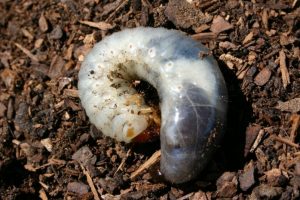
How do I know if my lawn is affected by grubs? As grubs feed on the grass roots in late summer, the lawn will begin to brown and wilt in irregular-shaped areas. If you suspect you have grubs, check the root zone of the affected areas for white, c-shaped grubs. Carefully pull back the narrow section of sod where the brown grass meets the green grass and search for the grubs; grub-damaged turf will fold back easily. Secondary damage can also be caused by raccoons and skunks digging up the lawn in search of grubs to eat.
What can be done about grubs? If the lawn is damaged by grubs, or raccoons or skunks feeding on the grubs, the lawn can be reseeded. The best time to reseed is in spring after the majority of grub damage is done. Rake the area to remove dead grass and uniformly distribute a high-quality grass seed. Ensure that the seed is in contact with the soil by raking it in. Afterwards, spread topsoil or compost over the seeded area. The seedbed should be kept moist until the seeds have germinated and the seedlings are well established. This may require a light sprinkling several times a day. Once the seedlings are mature, routine mowing and lawn maintenance can resume.
How can I prevent animals from digging my lawn for grubs? Raccoons and skunks can make a mess of the lawn when digging for grubs. You can deter these creatures from digging by placing mothballs or cayenne pepper over the damaged areas. Raccoons may also be scared away by motion activated sprinklers or porch lights.
Why does my lawn have grubs but not my neighbour’s? The mature stage of a grub is a flying beetle which can travel great distances before selecting a place to lay its eggs. These beetles typically select healthy areas of grass with full sun exposure and adequate moisture levels. When these conditions exist, there is a possibility that a grub problem may arise.
Crane Fly and Leatherjackets Leatherjackets are worms that are light grey or greenish brown with a black back. In spring and summer they feed on the crowns, stems, roots, and blades of turf. Be sure to keep an eye on irregular-shaped brown patches during April and May. Leatherjackets can also be found washed onto sidewalks after heavy rainfall. Crane flies resemble giant mosquitos and are noticeable in mid-September. Their eggs are laid immediately and hatch 10-15 days later. Newly hatched leatherjackets are found by late September and quickly grow as they feed to prepare for winter. Feeding begins again in April and continues until mid-June. There is no activity during the summer months. Treatments can be applied in the fall or early spring. Please contact us if you would like to request a quote to have crane flies or leatherjackets treated.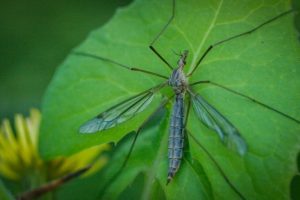
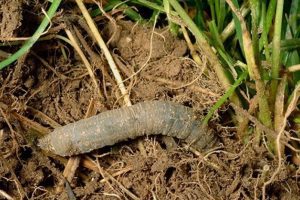
Chinch Bug A chinch bug is a small black insect that kills lawns by sucking on the grass stems. These bugs enjoy hot, dry weather conditions and can be found in sunny areas of the lawn. Damage will appear as dead, irregular-shaped patches but can spread to other areas. The dead grass will remain firmly attached to the ground. In combination with treatments that are applied in July or August, keeping the soil moist will help deter the insect.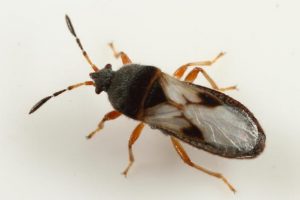
Common Lawn Fungus
General Fungi Information The fungi that commonly affect Ontario lawns are listed in the FAQs below. These fungi can be challenging to eradicate and require time and care to successfully control. No chemical treatments are available for fungi diseases, but fortunately these problems usually cause minimal lasting damage. The best solution for any fungi problem is to eliminate the conditions that allow fungi to flourish: removing thatch and reducing soil compaction with aeration, and the following tips listed below.
Fungi Tips
Necrotic Ring This fungi appears as brown rings ranging from 10 cm to 1 m in diameter. The grass inside the ring, however, remains healthy. Affected grass will turn yellow, with hints of red and purple on the stems before dying out. It appears in cool, wet weather in the spring and fall. We recommend washing out the affected areas with soap and water mixed with 3 oz of Listerine. This can be done every 4 weeks to disinfect the Necrotic ring.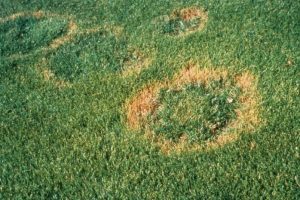
Summer Patch Summer patch appears as irregular brown patches and is often confused with fertilizer burns. It typically affects Kentucky bluegrass between June and September when weather is dry, humid and warm.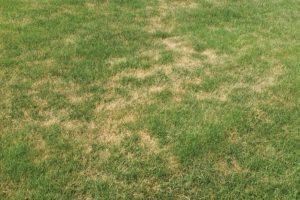
Rusts Weather patterns alternating between hot and dry to cool and wet can cause rusts, which appear as light yellow flecks on leaves and sheaths, followed by reddish‐brown coloured spores. Rusts can be rubbed off easily, but can leave a reddish tinge to shoes and equipment.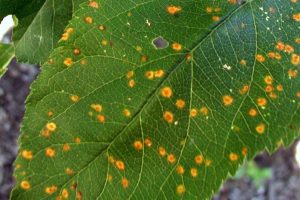
Pythium Blight This fungi can grow extremely quickly when the weather becomes hot and humid, causing infection and discoloration in a matter of hours. Early symptoms may include small dark spots about 2 inches in diameter with a slimy or greasy texture. These spots can increase rapidly in size.
During damp periods such as early morning, water-soaked leaves collapse and become matted together by a white mass called mycelium. The mycelium disappears as the grass dries and the dead blades turn brown. Damaged areas will oftentimes appear as long streaks due to the spread of spores and mycelium by mowing equipment.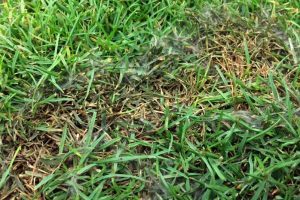
Leaf Spot Leaf spot occurs from spring through summer during warm, humid weather. They are small, dark purple and black spots that appear on leaf blades. As the spots become larger, the center will turn tan. When the temperature increases later in the season (above 28°C), the entire blade can appear dry and straw-coloured. Leaf spot occurs most often in lawns that are mowed too short.